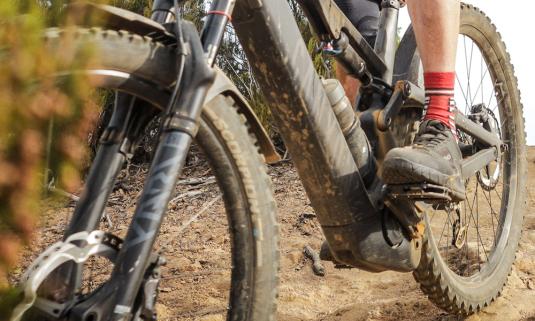More of the story
Okay. We've told you about a revolutionary, incredibly lightweight damping system that lets you quickly adjust the feel and performance of your suspension to match your riding conditions. A system that eliminates the need for pumps and tools, as well as the maintenance headaches you've come to expect from other platforms.
But how's it work, really?
First off, you'll have two ways to engage the tech - either with a crown-mounted adjuster, or a bar-mounted remote trigger. Forks will be available with one or the other. Whichever path you choose, Motion Control Damping gives you two options - "open" or "lock" - with a floodgate adjustment that lets you fine-tune the "lock" setting, and a compression adjustment for the "open" setting.
"Open"When you run with Motion Control Damping in the "open" position, you'll get maximum compliance and fork movement. The "open" position provides the ultimate in control and comfort, even when the terrain's at its roughest.
"Lock"In the "lock" position, Motion Control Damping still allows for a small amount of controlled fork movement. This movement enables your front tire to track the terrain without deflecting off ruts, roots and other obstacles, giving you better traction and steering control than you'd get with a complete lockout system.
Floodgate adjustment All Motion Control Damping-equipped forks will allow you to fine-tune the "lock" setting so you can resist bobbing while still having controlled suspension action in aggressive terrain. Simply choose the point you'd like the "lock" setting to "blow-off" and become active to force inputs like bumps and rocks. Under "lock," the maximum floodgate setting will generate minimal fork movement, while the minimum setting gives you increased fork movement.
All Motion Control Damping-equipped forks will allow you to fine-tune the "lock" setting so you can resist bobbing while still having controlled suspension action in aggressive terrain. Simply choose the point you'd like the "lock" setting to "blow-off" and become active to force inputs like bumps and rocks. Under "lock," the maximum floodgate setting will generate minimal fork movement, while the minimum setting gives you increased fork movement.
Compression adjustmentAvailable on some Motion Control Damping-equipped forks, the compression adjustment feature allows you to decrease fork movement in the "open" position. Compression adjustment can help combat brake dive and "squatting" under hard cornering.
Want more on Motion Control?How about the forks themselves, for cryin' out loud? Stay tuned for the next installment of the-red-pill.com.But how's it work, really?First off, you'll have two ways to engage the tech - either with a crown-mounted adjuster, or a bar-mounted remote trigger. Forks will be available with one or the other. Whichever path you choose, Motion Control Damping gives you two options - "open" or "lock" - with a floodgate adjustment that lets you fine-tune the "lock" setting, and a compression adjustment for the "open" setting.
"Open"When you run with Motion Control Damping in the "open" position, you'll get maximum compliance and fork movement. The "open" position provides the ultimate in control and comfort, even when the terrain's at its roughest.
"Lock"In the "lock" position, Motion Control Damping still allows for a small amount of controlled fork movement. This movement enables your front tire to track the terrain without deflecting off ruts, roots and other obstacles, giving you better traction and steering control than you'd get with a complete lockout system.
Floodgate adjustmentAll Motion Control Damping-equipped forks will allow you to fine-tune the "lock" setting so you can resist bobbing while still having controlled suspension action in aggressive terrain. Simply choose the point you'd like the "lock" setting to "blow-off" and become active to force inputs like bumps and rocks. Under "lock," the maximum floodgate setting will generate minimal fork movement, while the minimum setting gives you increased fork movement.
Compression adjustmentAvailable on some Motion Control Damping-equipped forks, the compression adjustment feature allows you to decrease fork movement in the "open" position. Compression adjustment can help combat brake dive and "squatting" under hard cornering.
Want more on Motion Control?How about the forks themselves, for cryin' out loud? Stay tuned for the next installment of the-red-pill.com.








